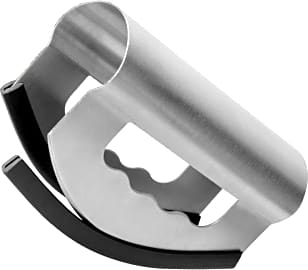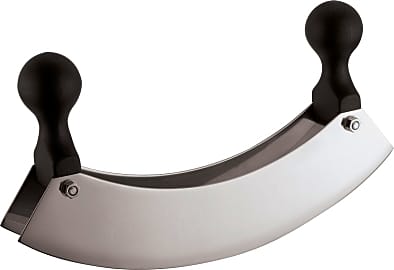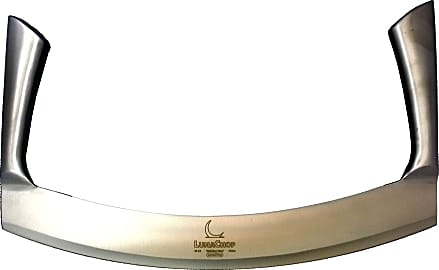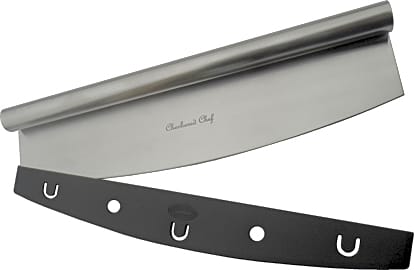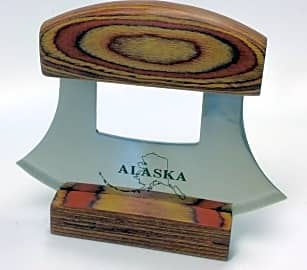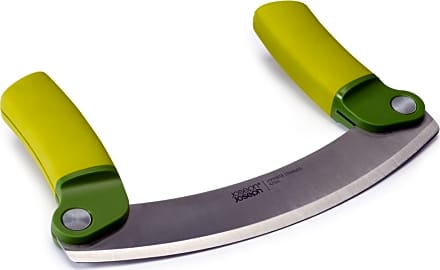The 9 Best Mezzalunas

This wiki has been updated 44 times since it was first published in February of 2016. Named after the Italian word for "half moon," mezzalunas have curved blades that are designed to rock back and forth in a quick chopping motion without putting your fingers at risk. They're generally used for mincing a lot of herbs at once, but they're also suitable for garlic, hard cheeses, cooked meat, and some vegetables. Some are even large enough to make slicing pizzas particularly easy. When users buy our independently chosen editorial picks, we may earn commissions to help fund the Wiki.
Editor's Notes
April 22, 2021:
As we've mentioned before, these are generally only used for one or two purposes, and as such, there's not a lot that differentiates them from each other. We did remove a one-handed, single-blade KitchenAid model that's hard to find and also uses too extreme of geometry. Trying to use a one-handed mezzaluna that's far too curved is always going to be less convenient than using a knife, so that one's out. For large-scale mincing, we still recommend the Paderno World Cuisine 48215 and Wüsthof 4736, and for rough chopping of salads, the Seth Chopper is a simple and affordable choice.
March 26, 2020:
Mezzalunas are somewhat speciality items that are most commonly used to mince herbs and garlic, cut fresh noodles, and separate pizzas and other flatbreads into slices. There's not a ton of difference from one to the next, so we've also included some options that are shaped very similarly, but either considerably larger or smaller.
The Arctic Circle Alaska Ulu is very much on the small side, as it has only a single blade and is designed to be used with just one hand. The KitchenAid KC173O is similarly small, and while it's not quite as attractive, it is more ergonomic and its silicone handle has plenty of grip. The Silchef Premium has two blades, much like many full-size models, which doubles the rate at which you can prep fresh herbs.
The LunaChop M-14 and Checkered Chef Rocker are very similar to classic mezzalunas, but rather than 8 or 10 inches, they measure 14 inches long. They're designed specifically to cut pizzas, but they are good at a number of things. The Bold Bee Stainless Steel is a bit shorter, at 12 inches, and while it won't work for large pizzas, it's much more like a traditional model and a bit easier to use than the big ones are.
If you're looking for a high-quality, long-lasting mezzaluna in the traditional Italian style, though, you'd be hard-pressed to do better than the Wüsthof 4732 for a single blade and the Paderno World Cuisine 48215 for a double. The Westmark Double Blade is a good and affordable choice, although its blades are noticeable closer together than those of the Wusthof or Paderno. The Joseph Joseph 10079 is the one to go for if you'll only use it sparingly, but do be careful, because its convenient folding handles can lead to injury if you're careless when taking it out of the drawer or when using and cleaning it. And when it comes to sharpening a mezzaluna, you'll want to use a stationary knife sharpener for best results.
With all that in mind, if you don't suffer from arthritis or other hand or joint issues (which mezzalunas can sometimes help mitigate), you should really consider getting a quality chef's knife, a good whetstone, and probably a honing steel. Most chefs don't use mezzalunas much, because a good knife can do just as good or better of a job.
No Knife Left Behind
To this end, a lot of culinarians amass huge collections of tools both new and old.
It's no secret that the most fun parts of being a chef are lighting things on fire and playing with knives. To this end, a lot of culinarians amass huge collections of tools both new and old. Modern technology provides cutting-edge metal alloys that help knives keep a razor edge long-term, but some of the most classic tools in the kitchen have withstood the test of time. The profiles of the most popular styles of chef's knife, for example, can be traced directly to much older French, German, and Japanese roots. The culinary field, itself, actually dates back to prehistory, when our ancestors began to build additional brain matter likely thanks to the widespread adoption of cooked food.
So, when you see a cleaver hanging on the wall that looks like it was born in an ancient, Chinese, mountaintop forge, you can bet there are some similar antiques lurking in a drawer nearby. After all, if it lasts for decades of professional use, it's safe to say it was made with care and attention in the first place and that it's a useful tool, no matter the current food trends.
Most effective cooking methods are well-established. We've known for a while how to properly chop, sauté, and emulsify ingredients. Traditional French techniques have made up a huge chunk of culinary school curriculum ever since aspiring chefs first stepped foot inside a classroom. So we can have faith that there's a place in the kitchen for old-fashioned methods and tools.
Shoot For The Moon
Many pros will attest that the most useful knife in their kit is their standard chef's knife. This go-to knife generally consists of a straight blade about 7 to 10 inches long with a tapered point. It's true that this simple blade can tackle a lot of different jobs in the kitchen. But specialized tools can make particular tasks far easier, and sometimes, the old implements are the best ones.
That brings us to the mezzaluna. Inspired by old world prep cooks and named after the Italian word meaning half moon, these interesting tools tend to look more suited to hand-to-hand combat than mincing produce. Nevertheless, the mezzaluna has held up over time and continues to have value in a cook's toolbox.
So if you're faced with a huge pile of herbs to process and you want to save your wrists some trouble, this is how.
There are a few reasons this unique knife serves a great purpose. It's incredibly effective at chopping herbs, for example. Yes, small and moderate amounts of fresh green aromatics can be chopped with a regular knife. For starters, using a mezzaluna makes these jobs faster because each hand is used to make cutting downstrokes, while a chef's knife uses its tip as a fulcrum, making it far less efficient.
The mechanical advantage doesn't just increase speed, though. The handles on these tools let you cut with more overall downward force while expending less energy. So if you're faced with a huge pile of herbs to process and you want to save your wrists some trouble, this is how. Otherwise, you might end up rocking your santoku back and forth until your hands get sore. Similarly, half-moon blades are great for home chefs with joint pain such as arthritis, thanks to how easy they are to grip.
Another reason these are well-suited to rough chops like herbs, dried fruit, nuts, and even chicken salad is their durability. Every time the blade of your chef knife suddenly hits the cutting board, it's pushed slightly out of true. Rapid mincing of herbs can quickly dull your blade without frequent honing. The mezzaluna's curved blade never slams violently against the cutting surface the way a straight blade does. Add in an increased thickness and a one-sided bevel, and they tend to hold up very well where other, more common knives would wear down.
As you may expect, mezzalunas do not excel in precision cutting. But that highlights one of their strengths: cuts, like the heritage of the knife itself, are simpler. The textures are rougher and the prepped food isn't as refined and perfect as you might expect from a Michelin star restaurant. And it's this rustic experience that's the cornerstone to some amazing meals in European cuisine and beyond.
So Many Knives, So Little Time
You'll notice right away that while all the options feature rounded blades, that's where most of the similarities end. There are small, one-handed models that work well for turning a pile of greens into a chopped salad with just a few strokes. Some of the most popular, larger models operate with both hands, giving you that added leverage and making your job much easier.
As with any knife, you need to keep these clean and sharp in order to maintain high performance.
Even the handles vary greatly; some are fixed like that of a knife, some are round knobs that provide extra power, and some even swivel closed when not in use to protect the blade. Most pizza places use an extra-large version of the mezzaluna to slice their pies in seconds, but even the medium-size half-moons work perfect on a pizza at home. Speaking of pies, any of the single-bladed options will work great for cutting sweet, warm, gooey, pecan or cherry goodness.
As with any knife, you need to keep these clean and sharp in order to maintain high performance. Most modern knives have a double bevel, where both sides of the knife's edge are ground and honed to meet in the middle at a sharp point. Some mezzalunas use only a single bevel. Only having one side ground to sharpness can keep food from sticking and building up on the flat of the knife during use while also keeping the knife in true. This is most important to remember when sharpening, as you should only sharpen the beveled side of the knife edge. But as long as you keep the blade honed and safely hung after it's cleaned — and not in a drawer where it could get nicked or otherwise damaged — you'll have an effective, old-fashioned, and high-quality tool at your disposal.


